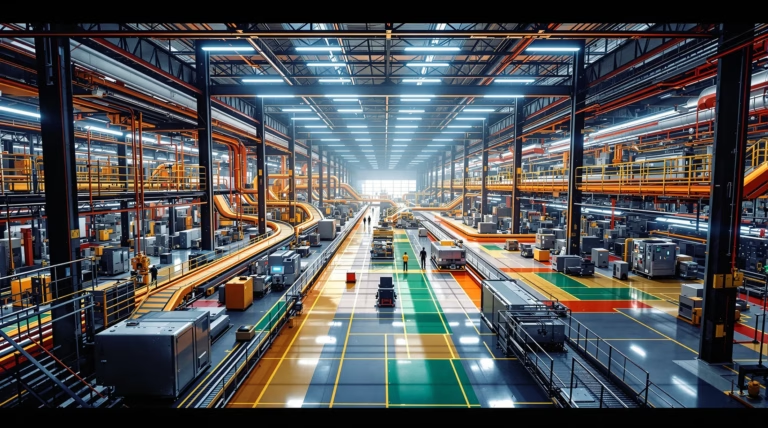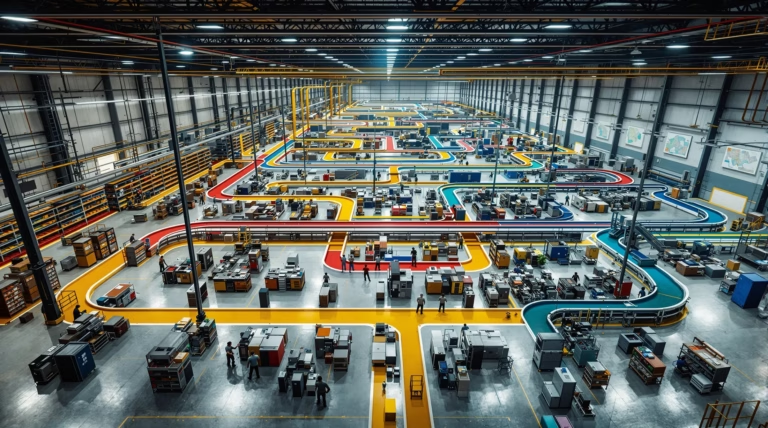Production Line Efficiency: Key Strategies for Improvement
Maximizing production line efficiency is crucial for manufacturing success in today’s competitive market. Learn how to measure, optimize, and maintain efficient production processes through proven strategies and metrics that drive sustainable growth.
Understanding Production Line Efficiency
Production line efficiency measures the relationship between output and input in manufacturing processes, determining how effectively resources transform into finished products while minimizing waste. This fundamental metric evaluates the system’s capability to convert raw materials, labor, time, and energy into finished goods with optimal resource allocation.
Efficient production lines create significant business advantages through:
- Prompt fulfillment of customer demands with high-quality products
- Optimized resource utilization leading to reduced operational costs
- Enhanced overall productivity and market competitiveness
- Increased potential for reinvestment in optimization and innovation
- Strengthened market position through continuous improvement
Key Metrics for Measuring Efficiency
Overall Equipment Effectiveness (OEE) serves as the primary benchmark for production line efficiency, combining three essential components:
| Component | Description | Impact |
|---|---|---|
| Availability | Scheduled operational time percentage | Reflects equipment reliability |
| Performance | Actual vs. designed speed ratio | Indicates speed efficiency |
| Quality | Good units percentage | Measures output excellence |
The Role of Throughput and Cycle Time
Throughput optimization directly influences manufacturing capacity and revenue potential. By eliminating constraints and maintaining consistent production flow, companies can fulfill more orders without significant infrastructure expansion. This capability creates a substantial competitive advantage in the marketplace.
Cycle time optimization works synergistically with throughput improvements by focusing on individual unit production duration. Shorter cycle times enable:
- Greater production capacity utilization
- Enhanced flexibility in market response
- Improved delivery schedule adherence
- Higher customer satisfaction levels
- Increased operational profitability
Strategies for Improving Production Line Efficiency
A systematic approach to efficiency improvement encompasses multiple aspects of manufacturing processes. Organizations implementing comprehensive strategies typically achieve 15-30% reductions in operational costs while maintaining consistent product quality.
Implementing Lean Manufacturing Principles
Lean manufacturing focuses on eliminating eight primary types of waste:
- Defects in production
- Overproduction issues
- Waiting time
- Non-utilized talent
- Transportation inefficiencies
- Inventory excess
- Motion waste
- Extra-processing steps
Companies implementing lean principles typically achieve:
- 20-30% increase in productivity
- 80% reduction in work-in-process inventory
- 90% decrease in lead times
- Sustained culture of continuous improvement
- Enhanced employee engagement in optimization efforts
Identifying and Eliminating Bottlenecks
Bottlenecks represent the most significant constraints in a production system, acting as chokepoints that limit overall throughput regardless of improvements elsewhere in the line. Effective identification combines systematic data analysis with observational assessment to pinpoint areas where work-in-progress accumulates, cycle times exceed targets, or equipment consistently operates at maximum capacity.
- Short-term solutions:
- Redistributing workload to parallel stations
- Adjusting staffing patterns
- Implementing quick equipment modifications
- Long-term solutions:
- Investing in additional capacity
- Upgrading equipment
- Redesigning workflows entirely
The Theory of Constraints methodology provides a structured approach that can increase production capacity by 20-30% with minimal capital investment:
- Identify the constraint
- Exploit it fully
- Subordinate other processes
- Elevate or break the constraint
- Repeat for next bottleneck
Enhancing Skills through Employee Training
Employee training serves as a cornerstone for boosting production line efficiency. Well-designed programs enable workers to operate equipment more effectively, troubleshoot issues independently, and contribute valuable improvement suggestions based on their firsthand experience.
| Training Impact | Improvement Rate |
|---|---|
| Productivity | 10-15% increase |
| Quality Issues | 40-60% reduction |
| Employee Retention | Significant improvement |
Comprehensive training programs should encompass:
- Technical skills for equipment operation
- Quality control procedures
- Problem-solving methodologies
- Cross-training across multiple positions
- Understanding of efficiency principles
Technological Advancements in Production Efficiency
Modern manufacturing facilities leverage Industry 4.0 technologies to achieve unprecedented efficiency levels. The integration of IoT sensors, cloud computing, and artificial intelligence transforms traditional production environments into smart, connected systems capable of self-optimization. Early adopters report productivity increases of 15-25% and maintenance cost reductions of up to 40%.
Utilizing Production Line Monitoring Software
Modern monitoring systems collect data from multiple sources across the production floor, delivering actionable insights through intuitive dashboards. These platforms typically achieve ROI within 6-12 months through:
- Real-time analytics for instant issue identification
- Historical trend analysis for pattern recognition
- Remote monitoring capabilities
- Predictive maintenance indicators
- Performance optimization insights
The Importance of Preventive Maintenance
Preventive maintenance delivers substantial benefits through systematic equipment management:
| Benefit | Impact |
|---|---|
| Unplanned Downtime | 30-50% reduction |
| Equipment Lifespan | 20-40% extension |
| Equipment Reliability | 95% achievement rate |
| ROI | $5-$10 per dollar invested |
Leveraging Data Analytics for Process Improvement
Data analytics has transformed manufacturing by converting vast production data into actionable intelligence. Advanced analytics platforms process information across the entire value chain, revealing correlations and relationships that human analysts might overlook. These insights enable precise process adjustments, leading to documented improvements:
- Cycle time reduction: 15-30%
- Quality improvements: 10-20%
- Elimination of hidden process variations
- Enhanced predictive quality control
- Dynamic production sequence optimization
| Analytics Stage | Capability |
|---|---|
| Descriptive | Current performance and historical trend visibility |
| Diagnostic | Root cause identification of issues |
| Predictive | Anticipation of potential problems |
| Prescriptive | Specific action recommendations based on modeling |
Sustainability and Standardization in Production
The integration of sustainable practices with rigorous standardization creates dual benefits: reduced environmental impact and significant cost savings. Organizations implementing this approach typically achieve 15-20% reductions in operational costs while maintaining compliance with environmental regulations. This strategy transforms potential constraints into competitive advantages in markets increasingly focused on both efficiency and environmental responsibility.
Incorporating Sustainability Initiatives
Modern sustainability initiatives fundamentally reshape manufacturing operations through comprehensive energy monitoring systems and resource optimization strategies. Companies implementing these programs achieve:
- Energy savings: 10-30% reduction
- Minimized input requirements
- Improved material utilization rates
- Enhanced worker conditions and safety
- Reduced production waste streams
The Role of Standard Operating Procedures
Well-designed SOPs establish the foundation for consistent and efficient production operations. Organizations with mature SOP implementation report:
- Process error reduction: 25-40%
- Improved training efficiency
- Enhanced quality parameters
- Optimized equipment settings
- Streamlined troubleshooting protocols
Advanced SOP systems incorporate visual management principles and digital interfaces that improve comprehension and adherence. Regular review and updates based on performance data and operator feedback transform SOPs into dynamic tools for ongoing efficiency optimization across all production activities.







